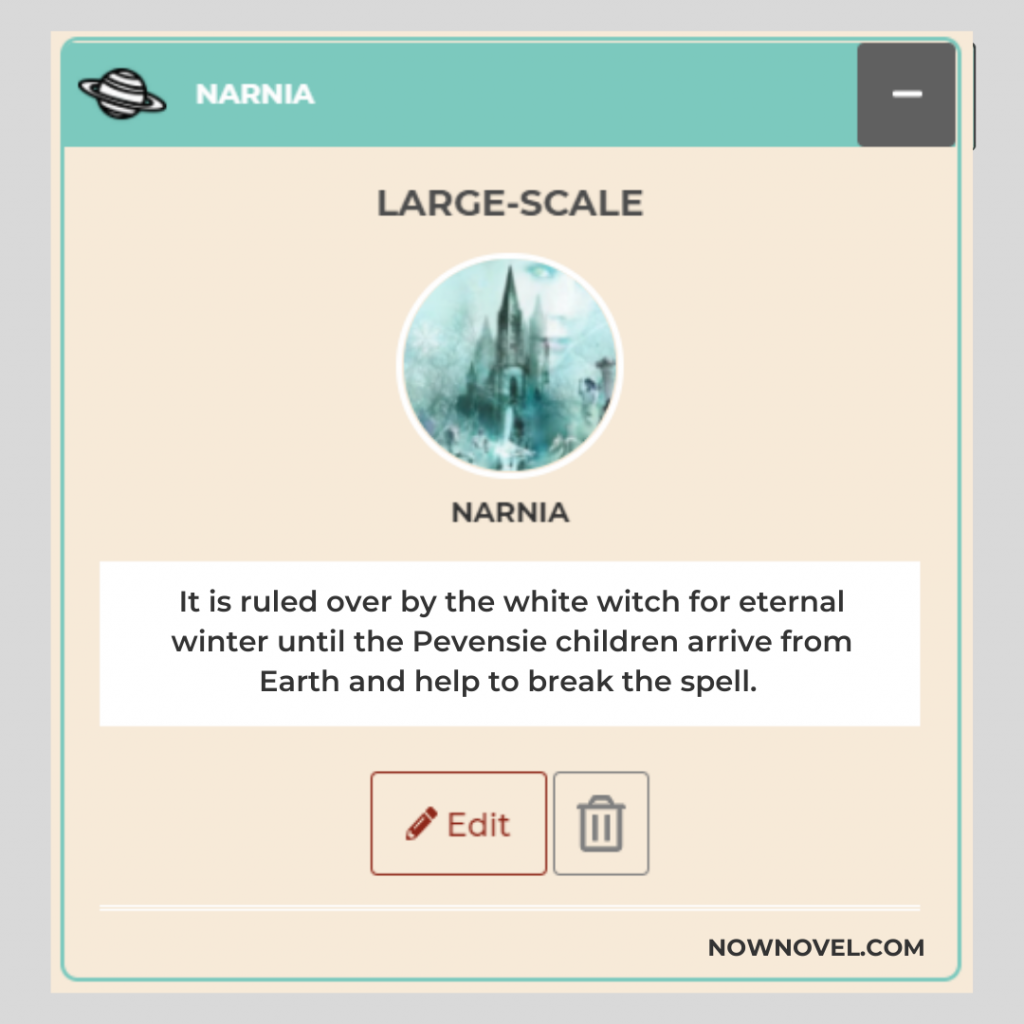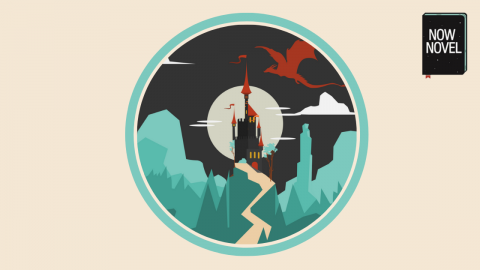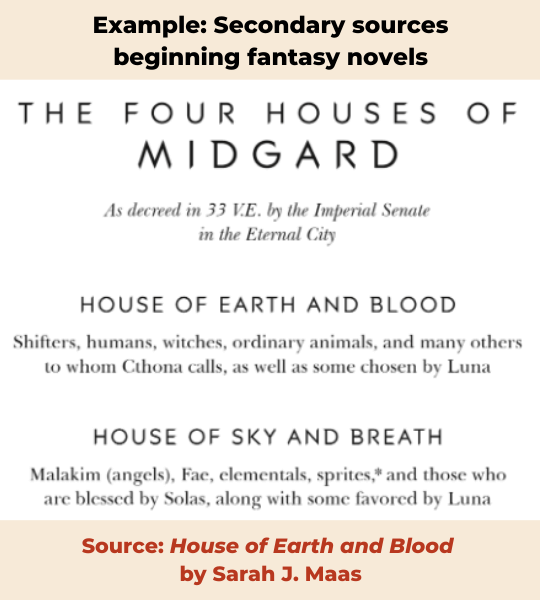Learn how to start an epic fantasy story and create intrigue. Read examples from great fantasy novelists, plus the insights they share:
How to start a fantasy novel: 6 creative methods
- Start with broad worldbuilding
- Begin with unique place details
- Launch into customs or culture
- Start with a suspenseful prologue
- Give helpful secondary sources
- Dive into action
Let’s explore these ideas further, with examples from hit fantasy novels:
Start with broad worldbuilding
Worldbuilding is an essential part of fantasy. Create an outline, though, to map out your world, see where there might be plot holes. Draw a map of the world you have imagined. Flesh out your cast to create believable characters.
Your fantasy novel or fantasy series may span a single world or multiple worlds (a multiverse) or dimensions. Consider too, whether you are writing a dark fantasy, combining horror with fantasy, bringing in supernatural elements. Will it be an urban fantasy set in a city? What kind of city? What elements, if any, of everyday life will you introduce?
Starting a fantasy story with broad worldbuilding is thus a useful way to introduce your reader to broad details of place and history such as:
- The origins of the world(s) (much the same way as the Old Testament begins with the Book of Genesis)
- How people or other species, races or classes (mages, witches, wanderers and others) came to exist or move between worlds
- History, rule, and other details of society and ‘long’ time
Example of a fantasy novel starting with worldbuilding: The Magician’s Nephew
The first book (not by publishing order) in C.S. Lewis’ famous Narnia series is The Magician’s Nephew.
In the first chapter, ‘The Wrong Door’, Lewis introduces the reader to two children living in London who discover a portal to Narnia.
At the start of this fantasy, we read broad information about the world of Narnia and its relation to earth:
This is a story about something that happened long ago when your grandfather was a child. It is a very important story because it shows how all the comings and goings between our world and the land of Narnia first began.
C.S. Lewis, The Magician’s Nephew (1955), p. 9
The opening paragraph is fitting as it introduces a prequel to the world of Narnia that was published five years after the first published in the series, The Lion, The Witch and the Wardrobe (published in 1950).

This worldbuilding intro thus tells the reader that they will be learning more about a universe already familiar from Lewis’ previous books.
[Ed’s note: There is interesting discussion on the correct order to read the Narnia books in on Narniaweb. And read our post on how CS Lewis incorporates poetry in his fiction.]
This way to begin is effective because the story is a prequel. An older person telling us a tale of Narnia’s ‘pre-history’.
Start your fantasy epic
Brainstorm story outlines and answer prompts to flesh out a fantasy world in vivid detail.

Begin with unique place details
Deciding how to start a fantasy story presents many choices.
Will you describe broad world details (as Lewis does in the example above) or the specific details of a particular place?
The advantage of beginning with concrete visual or geographic details is you can conjure specific tone and mood.
There’s magic in this type of story beginning – just look at the opening to Sir Terry Pratchett’s The Colour of Magic, the first in his famous Discworld series:
Example of starting fantasy with specific place details: The Colour of Magic
The Colour of Magic, the first in Pratchett’s classic satirical fantasy series, begins (after the prologue, which gives broad worldbuilding about the cosmos):
Fire roared through the bifurcated city of Ankh-Morpork. Where it licked the Wizards’ Quarter it burned blue and green and was even laced with strange sparks of the eighth color, octarine; where its outriders found their way into the vats and oil stores all along Merchant Street it progressed in a series of blazing fountains and explosions; in the streets of the perfume blenders it burned with a sweetness; where it touched bundles of rare and dry herbs in the storerooms of the drugmasters it made men go mad and talk to God.
Terry Pratchett, The Colour of Magic (1983), first chapter excerpt available here.
Pratchett shows us details about the city of Ankh-Morpork. We learn:
- That it is bifurcated (split into two)
- That it is burning
- That there are quarters for wizards, merchants, perfume blenders’ streets.
This fantasy fiction opening conjures a world richly alive with vibrant detail and magical elements (despite Neil Gaiman advising readers not to begin with Book 1).
Think of interesting, unique place details. You could start a fantasy by describing:
- cities
- quarters
- streets
- ceremonial spaces
- hideouts for magical beings
- castles
- hovels
- meeting points between worlds
What spaces and location details in fantasy have fascinated you in your reading? What fantasy elements have intrigued you while reading in the fantasy genre? Create that same opening magic.
Launch into customs or cultures
In deciding how to start writing fantasy, it’s easy to focus on place description.
Place is environment and action. A history of actions (and their effects on environment), too. Customs, ceremonies, rites and rituals. Celebrations, festivities too.
Brainstorm customs specific to your world.
These could be:
- magical rites
- rituals around power and succession
- induction of initiates into magical powers
- ceremonies to appease or otherwise communicate with spiritual figures such as deities or guardians
Worldbuilding is part what your world looks like, part what it feels like to live there.
Example of starting fantasy with customs: The Unspoken Name
A.K. Larkwood’s 2020 fantasy debut, The Unspoken Name, featured on many ‘best fantasy of 2020’ lists.
Larkwood’s novel, about an orc rescued from intended sacrifice to become an assassin and spy, begins with details about intriguing local customs:
In the deep wilds of the north, there is a shrine cut into the mountainside. The forest covers these shrines like a shroud. This is a quiet country, but the shrine of the Unspoken One is quieter still. Birds and insects keep away from the place.
A.K. Larkwood, The Unspoken Name (2020), p. 10
In the valley below the Shrine is a temple known as the House of Silence. Its acolytes leave offerings at the foot of the steps that lead up to the Shrine, but they do not come any closer.
The beginning of this fantasy story immediately tells us something about both a fantasy setting and the way acolytes live and follow customs within it.
The way the shrine is described creates mystery and suspense. Why it’s called ‘the House of Silence’, for example. A name itself can be a powerful source of suspense.
Start with a suspenseful prologue
Prologues have long been a common way to start a fantasy story.
Why is this? Fantasy prologues are useful beginnings because they:
- Provide a way to share worldbuilding outside the main arc or timeline of the story (example: JRR Tolkien’s prologue to his The Lord of the Rings cycle)
- May share interesting or relevant historical, cultural or other information (e.g. Sir Terry Pratchett using the prologue to The Colour of Magic to describe the cosmos home to his world)
When you start your fantasy novel with a prologue, this doesn’t need to be dry or ‘textbook’ historical. An example:
Example of starting fantasy with a suspenseful prologue: Rhythm of War
Brandon Sanderson’s epic fantasy novel Rhythm of War, the fourth book in his popular The Stormlight Archive series, begins:
Of course the Parshendi wanted to play their drums.
Brandon Sanderson, Rhythm of War (2020).
Of course Gavilar had told them they could.
And of course he hadn’t thought to warn Navani.
The prologue, simply titled ‘seven years ago’, creates immediate suspense in the simple action of playing drums, and Gavilar’s double-bind.
The reader may well wonder why Gavilar had to warn Navani about the drummers. The prologue throws us immediately into intriguing action relevant to Sanderson’s world and its customs.
In starting your fantasy novel, ask:
- Who could be in a tough or suspenseful situation, and why?
- What action or intent could create mystery (the way playing drums requiring that a warning is issued first creates suspense above)
Give helpful secondary sources
Fantasy is the genre of intriguing secondary sources.
Front pages explaining dynasties, place names and pronunciations. Maps, decrees and even architectural cross-sections.
Thinking about your world, what secondary sources could be interesting and create the sense of a full, richly textured world?
It could be the fragment of a historical treaty, printed to resemble a torn and aged scrap, for example.
The function of secondary sources in fantasy introductions is twofold:
- They tell your reader an interesting detail about your fantasy world
- They create the sense of history (an artefact, or historical or geographical record) that makes a world feel real
Example of secondary sources in fantasy beginnings: House of Earth and Blood
Sarah J. Maas’s House of Earth and Blood won the Goodreads Choice Best Fantasy award in 2020.
At the start of the book, Maas gives a list of Houses, categories different types populating her world are divided into:
Starting your fantasy book with categorical details like this helps the reader to place and sort your world’s core information.
Dive into action
In choosing how to start a fantasy story, you don’t have to introduce magic straight away.
A tense or urgent action provide a strong hook in almost any genre. Adventure books and fantasy novels share this in common in particular. Introduce the source of conflict in the story with such an opening, too. Decide on the central conflict. Who is the main protagonist in conflict with? What do they want or need to achieve in the story? Consider the external conflict that will be key to your story’s theme.
You could of course also combine elements, to give both immediate action and begin worldbuilding. There are countless ways to make your beginning bold.
What actions beginning fantasy stories are intriguing? There are so many possibilities:
- Characters fleeing wars, mistakes, wizardry
- Initiates getting spells right (or wrong)
- A magical departure, arrival, or precipice (for example, a summoning at a tense, decisive moment of success/failure)
An example of this type of fantasy beginning:
Example of starting fantasy with tense action: The Invisible Life of Addie LaRue
V.E. Schwab’s The Invisible Life of Addie LaRue appeared on many best-of-fantasy lists in 2020.
The novel, in which the main character makes a deal with the devil for immortality, begins:
A girl is running for her life.
The summer air burns at her back, but there are no torches, no angry mobs, only the distant lanterns of the wedding party, the reddish glow of the sun as it breaks against the horizon, cracks and spills across the hills, and the girl runs, skirts tangling in the grass as she surges towards the woods, trying to beat the dying light.
V.E. Schwab, The Invisible Life of Addie LaRue (2020).
Schwab’s opening provides an immediate sense of danger and urgent action. We wonder why the girl is fleeing the wedding party, and why she needs to beat the dying light.
Find 200 fantasy story prompts in twenty organized categories to get going.
Use the Now Novel story builder to create a blueprint of your fantasy novel – work out details of character, setting and mood that will bring your fantasy world to life.





9 replies on “How to start a fantasy story: 6 intriguing ways”
I hope to write a work of Fantasy very soon. Say, I could write Science Fantasy, though.
Hi Twin. I’m looking forward to reading critique extracts on Now Novel. Start it now while you feel motivated and inspired 🙂
Thanks for the perspective, Duke. Good point, hence the qualifier ‘too’. If you think of Mordor, however, it’s hardly hospitable land. Yet there are manoueverings of Empire that make the invasion or rather infiltration very necessary. So as always, it all depends.
All you say here that we should do…is actually what Harry Potter contains, Lord of the rings contains etc…so all this nowdays is the usual stuff…maybe we should turn to the unusual stuff and break all the rules finally…Fantasy should not have rules 🙁
I feel this is more to help with inspiration and how it’s usually started. Obviously do not use the same beginning. Fantasy should not have rules on how to start or finish a story I completely agree. That is one of the many reasons it is my favorite genre. But like I said before this is more an article for inspiration, not for setting rules. 🙂
Hi Laur, absolutely! Thank you for pointing this important distinction out. These are general patterns/strutural decisions one can make (in terms of what type of material/focus one could begin a fantasy story with). That is one of the lovely things about fantasy, how it makes the impossible possible. Thank you for sharing your thoughts ?
When I build a world from a scratch, I use the “snowball” method. Here’s how it works: I start with something and slowly add details. In this way, the connections gradually build up, the shortcomings become visible, and I keep writing more and more.
I feel it’s good and more valuable writing. it’s very useful for me.
Good to hear that, thanks for letting us know it was useful. All the best with your writing!